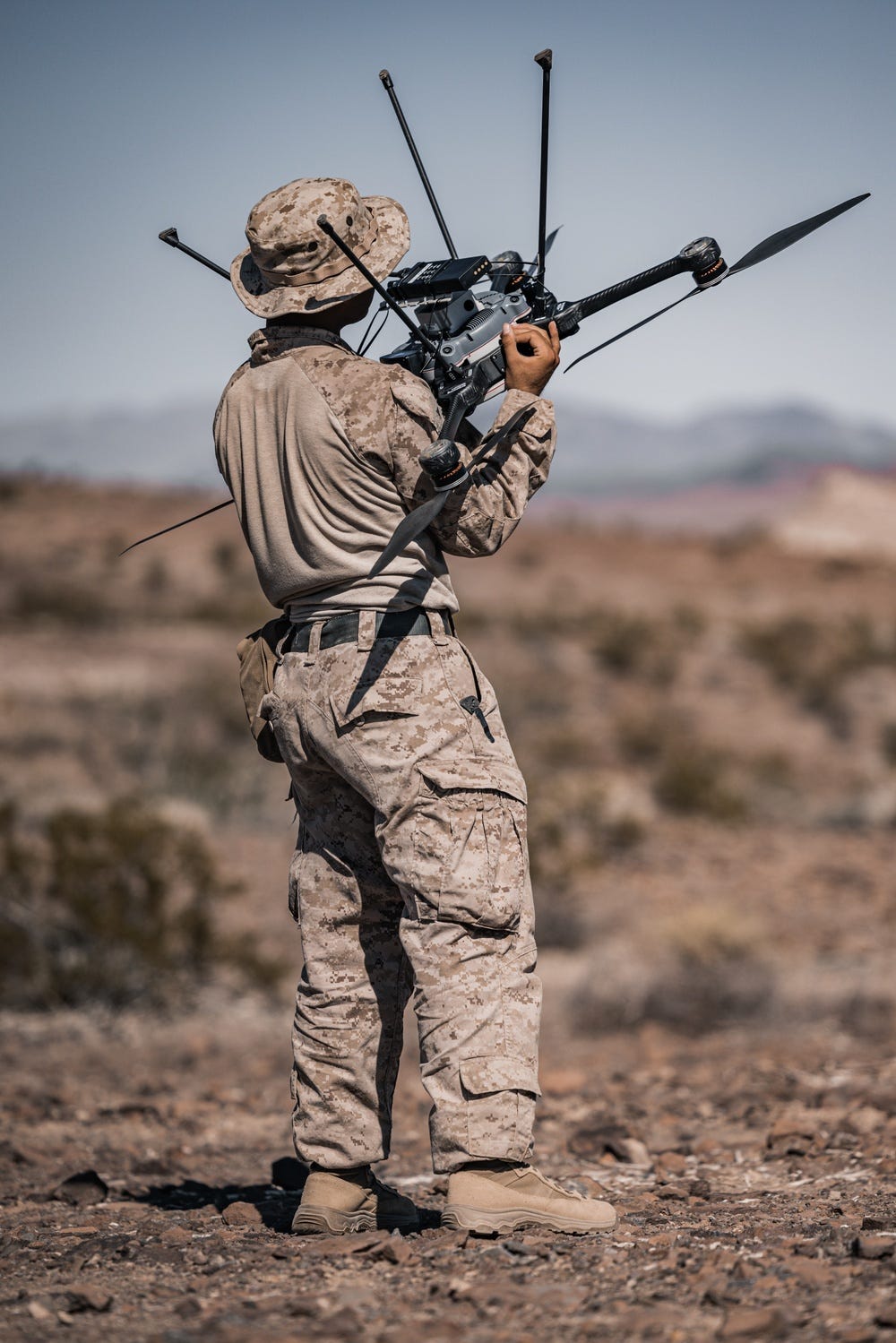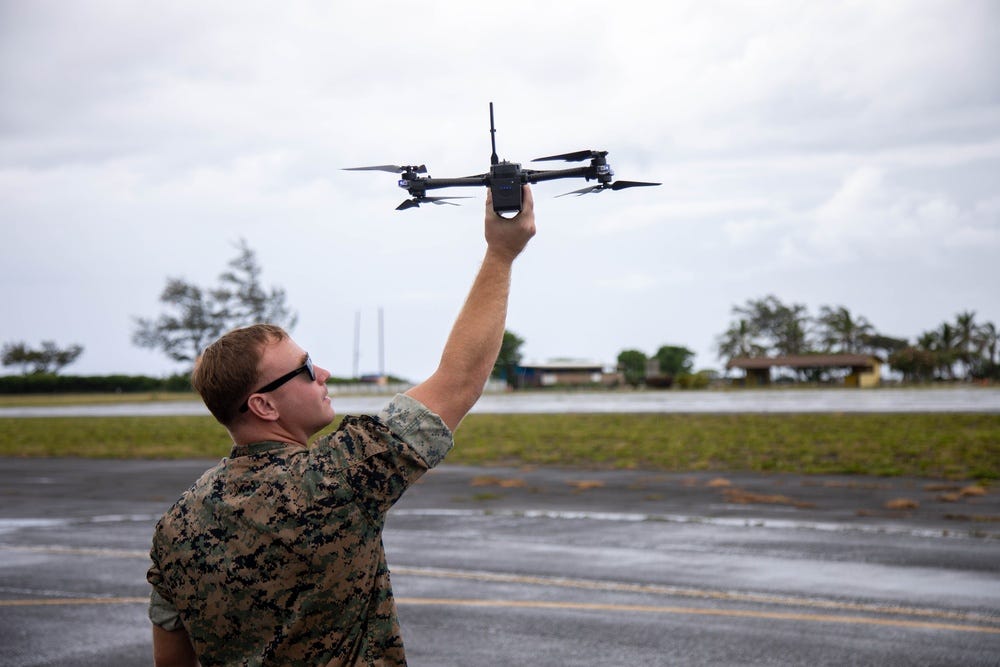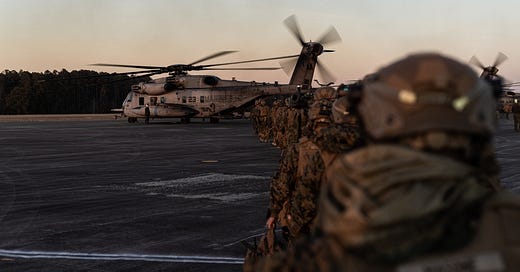Groups of foot soldiers remain to this day among the most powerful and influential forces on the battlefield. The Infantryman has been, continues to be and will remain a durable element of the battlefield even as technologies and combat environments change.
sUAS is changing the character of war much like the machine gun of World War I, perhaps validating an assertion made five years ago that the “machine gun of the twenty first century” is the armed drone
Since the “maneuverists’ movement” began in our Corps in the 1970s, Marines have prided themselves on being warfighters who understand that quickly closing on an objective requires timely and sustained suppression. Suppression is the critical infantry task, for without suppression on a contested battlefield, maneuvering invites annihilation. This mindset has been proven repeatedly in training and combat. New technologies such as small unmanned aircraft systems (sUAS) at the company level should allow for Marines to quickly close on an objective. As a learning organization, we must identify how capabilities such as those employed in the Nagorno-Karabakh conflict, the war in Ukraine and most recently in the Middle East, support maneuver for a rifle company in its task to sense, make sense, suppress, and close on an objective. This short article provides lessons learned on sUAS employment in support of company offensive operations.
Background Information
The Scenario. As part of the 2D Marine Division’s Marine Corps Combat Readiness Evaluation (MCCRE) each rifle company is evaluated on their ability to conduct a combined arms supported, non-illuminated, live fire night attack while integrating all available weapon systems in an infantry battalion to allow the infantryman to close on a fortified enemy position. These offensive attacks are known as the “APEX” attacks. “The term APEX represents the most competent, capable, and lethal a unit can be. APEX status is the desired end state for 2D Marine Division units as they progress through their pre-deployment training program making them immediately employable by their gaining command once deployed.” 1st Battalion 8th Marines conducted their APEX attacks in August of 2023 prior to chopping to the 24th MEU in preparation for the upcoming deployment.
The Equipment. BLT 1/8 Rifle Companies employed the RQ-20B Puma continuously throughout all stages of the operation. At the company level, the R80D SkyRaider was also employed as a form of redundancy for the Puma. Rifle Platoons employed the SkyDio X2D.
RQ-20B Puma provides a time on station of 90-105 minutes with the I45 payload and 150-180 minutes with the I25 payload which enabled the company to positively identify enemy indirect fire assets prior to departing from the tactical assembly area. With a max range of 10-20km and maximum altitude of 10,000ft, the platform had the endurance and range to support the company throughout the duration of the operation.
R80D SkyRaider is a larger, platoon and company level quad copter capable of supporting a wide range of mission oriented payloads. This platform has shown to be capable of effectively supporting targeting and adjustment for mortar fires up to ranges of approximately 2km from the aircraft.
SkyDio X2D is a small, squad and platoon level quad-copter platform. Its ground control station is a small hand controller featuring an embedded Samsung phone that provides all C2 and receives video feed from the aircraft. It has a powerful sensor suite capable of both EO and IR simultaneously through Picture-in-Picture (PiP). It also has a built-in moving map software that can be used for navigation and orientation.

Planning and Execution
Adapting for the Future. During the conduct of its APEX attacks, Company A along with its sister companies in BLT 1/8 found creative and useful ways to employ sUAS to support its reconnaissance, shaping, and closure stages of an offensive operation in order to close on an enemy fortified position.
Reconnaissance
The RQ-20B Puma provided reconnaissance of the objective area prior to the company moving within the direct fire weapons engagement zone and without the concern of audible compromise over the objective area.
Establishing the Puma in the overhead took each Company anywhere from 5-20 minutes following launch and establishment of a video downlink as well as identifying any potential targets.
Weather such as wind and user familiarity with the Puma affected the time it took for the Puma to be launched and connected with the Ground Control Station prior to observing enemy positions.

Shaping
The most valuable utilization of the RQ-20B in support of the company attack was the utilization of sUAS as an observer in concert with the company FIST to neutralize the enemy indirect fire assets. This occurred prior to the company departing from the tactical assembly area. During APEX attacks it was essential to set conditions for the company by neutralizing the enemy indirect fire assets prior to conducting shaping actions on the objective area. The company found that establishing the Puma ground control station in the vicinity of both the launch point and company FIST position, enabled direct line of sight connection for the Puma, and Puma operator, to identify the enemy indirect fire assets. Upon sensing and identifying the enemy’s indirect fire assets with the Puma, the company Puma operator was able to conduct a call for fire mission with 81mm mortars to neutralize the threat. This employment method allowed the company to neutralize the threat without exposing an observer or additional battalion assets to the enemy.
The aforementioned method however limits the company as the Puma operator and FIST team is tethered to the ground control station antenna thus keeping the operator at the launch and recover site and by extension, anyone trying to observe fires. The battalion and 6th Marine Regiment, found that the PRC-165 and Video down link on the Tactical Handoff system (found in a JTAC suite) offers the ability to have a FIST leaders view of the Puma feed and mark targets for the Puma operator to call for fire if the Puma is within line of site of the PRC-165 (Figure A). This enables the company FIST to move with the company and conduct shaping operations without remaining tethered to the launch point or Puma operator and the ground control station. Although untested by the battalion, in theory this also allows for the Puma to be launched from a launch point further away, perhaps the battalion rear area, and could allow the company to “catch” the puma from a separate ground control station (hand over of operator control) allowing the company to extend the range by separating itself from where the Puma is located. This would eliminate the ability for the enemy to identify maneuver units if they can find the launch point of the puma.
Maneuver
“If you can’t do it at night, you are not trained”. Utilizing the Puma at night during the APEX attacks provided an immense amount of benefit for the company closing on multiple fortified positions. Much like the PEQ-16 provides the small unit leader the ability to mark targets and provide talk-on to Marines closing on an objective, the Puma provides the same capability at the company level with the IR “sparkle”. Integrated with a closure series, the PUMA in the overhead provided an IR illuminator to mark target reference points (TRPs) for machine guns and MAWWS gunners and marked targets at night for anti-armor assets such as the JAVELIN. This allowed the unit to quickly orient on and engage a target within the commander’s target engagement priorities and criteria at night. This increased the overall tempo and direct fire suppression thus allowing the company to close faster at night.

Additionally, employed much like a JTAC and Commander would utilize the sensors and pods of an aircraft during a raid to identify the enemy on an objective area, the Puma with its IR illuminator was able to mark an entire 200m trench system for squads and platoons to better see the targets at night as they closed on the objective area. As the company closed on the three trench systems during APEX attacks and as a squad gained a foothold, the company commander was able to employ the Puma over the radio to slew the IR “sparkle” to the next trench system. This allowed for those on the objective area to know where lead trace was, but more importantly, this action increased visibility to engage targets at night for the 0311 on each trench system that maneuver units were closing on. Even if communication with the Puma operator was lost over the radio, as long as the operator understood the intent and scheme of maneuver the operator was able to move the IR “sparkle” independently to support the company’s closure at night.
As the company was in the assault position assessing effects from 81s, 60s, heavy machine guns and medium machine guns on the objective, the company employed the Skydio and found it extremely effective in Camp Lejeune like terrain (visibility no more than a 100m in the summer time) in the tree line to observe effects from direct fire and indirect fire suppression prior to unmasking form its assault position. The Skydio was employed by the assaulting platoon in its assault position with the company commander to measure the effectiveness of direct and indirect fire suppression. The company commander and platoon commander were able to observe the effects of fires on the Skydio controller screen without exposing themselves to the enemy position. Utilization of the sUAS with the assaulting elements not only provided visibility of the enemy but also enabled the maneuvering unit to assess effects without exposing themselves to direct fire from the enemy enabling them to remain masked by terrain.
Consolidation. sUAS in support of consolidation with the PUMA in the overhead allowed the company to identify a counterattack prior to any enemy effects on the unit (as Marathon targets closed on the objective) and was able to utilize its IR “sparkle” to highlight the enemy for easy target acquisition at night.
Limitations
The footprints for both payloads are not ideal for light infantry and foot mobile units thus creating a limitation for units that are unable to employ vehicles or UTV/ULTVs with the company. Ideally, a battalion can launch the puma for a position further away from the company and allow for the company to “catch” the Puma and receive control of the Puma in flight by employing a ground station. This would eliminate the concern of bringing the large footprint on aircraft or in vehicles. For instance - the Puma with the I25 pay load comes with four cases measuring 58”x17”x11” and the I45 payload is three cases.
Recommendations
Continue to explore options for controlling fires via sUAS, to include the PUMA observing for 81’s with an FDC.
The SkyDio can be an aid for a 60mm mortar section leader to observe for 60’s using Direct alignment.
Continue to employ the SkyRaider with 81’s FDC and spot/plot method.
Employment of SkyDio at the squad and platoon level allow for units to assess the effects of suppression from indirect fire and direct fire suppression without unmasking from concealed or covered positions.
In my opinion, the best combination was utilizing the Puma as an observer for 81s and the Skydio for 60s direct alignment. The Puma offers the greatest return on investment at this time.
Continue to pursue options to get away from being tethered to the Puma ground control station to include use of PRC-165/VDL as well as operator hand-offs in order to stretch the legs of systems and mask launch points.
It is recommended not to overly rely on one sUAS the primary observer for fires. Continue to plan on an primary and alternate observers for fires however in the case of employing sUAS as the observer it is recommended to have an alternate available such as the SkyRaider that has the payload and operating system to allow an observer to call for fire.
It is recommended early in a battalion’s life cycle to integrate sUAS training with the battalions FSCC and battalion 81s FDC.
The Value Proposition.
An investment in time, resources, and training with sUAS for our infantry companies will exponentially increase their lethality. These capabilities will also enable the company commanders to shorten kill chains in support of the maneuver elements while, importantly, maintaining organic fires capabilities with ranges that extend the range of traditional observation of fires. The challenge – and opportunity – before us is to determine how to usher in this transformation while still maintaining the ability to employ three rifle squads in a platoon.
The Marine Corps is at an inflection point in its history and the rifle company is poised to lead the way into the future with a tactically sound, historically grounded, and innovative task organization. In 2006, the Israeli Defense Force discovered the vulnerability of its tanks against well laid, anti-armor, guided missile ambushes. Similarly, Iraqi and Syrian forces found their armored vehicles easily found and targeted by weaponized drones beginning in 2015. This is to say nothing of the US’ own experiences against landmines and improvised explosive devices over the last twenty years. Utilizing sUAS at the squad, platoon and company level will allow the rifle company of tomorrow to both exploit peer competitors’ reliance on legacy systems while remaining light and mobile enough to deny the enemy a similar opportunity.
Captain Joe DiPaola is an Infantry Officer and Company Commander with Battalion Landing Team 1/8, 24th Marine Expeditionary Unit (MEU).








Great job, Captain DiPaola! The challenges of future combat require leaders like you, and the Marines of your battalion - those who are willing to try out new gear, experiment, break things, fail, try again, and then share their ideas. I think you hit the nail on the head: "UAS are revolutionizing ground combat."